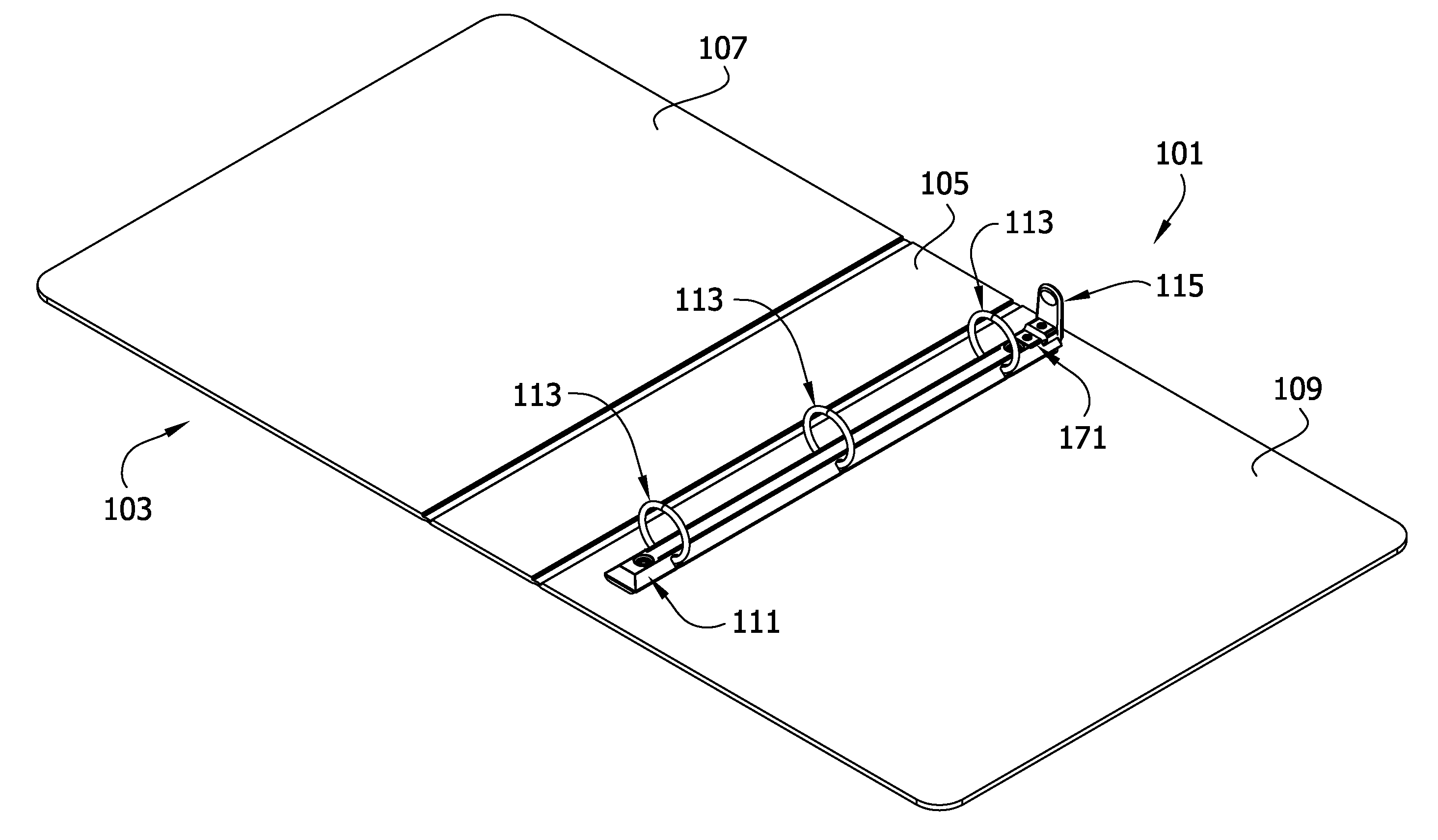Ring binder mechanism having dual time buffer actuator
a time buffer actuator and ring binder technology, applied in the field of ring binder mechanism, can solve the problems of user injury, inability to retain loose-leaf pages, and risk of rings inadvertently opening
- Summary
- Abstract
- Description
- Claims
- Application Information
AI Technical Summary
Problems solved by technology
Method used
Image
Examples
first embodiment
[0026]Referring to the drawings, FIGS. 1-2 show a ring binder mechanism of the invention, generally indicated at 101. In FIG. 1, the mechanism 101 is mounted on a notebook cover 103. Specifically, the mechanism 101 is mounted adjacent the spine 105 of the notebook cover 103. The spine 105 extends between front and back covers 107, 109 that are hingedly attached to the spine 105. The front and back covers 107, 109 are moveable to selectively cover or expose loose-leaf pages (not shown) retained by the mechanism 101. Ring binder mechanisms mounted on a notebook cover in other ways (e.g., on the spine) or on substrates other than a notebook cover (e.g., a file, a briefcase, etc.) do not depart from the scope of this invention.
[0027]As shown in FIGS. 1 and 2, the mechanism 101 includes an elongate housing 111 supporting a plurality of rings (each of which is designated generally 113). The housing 111 has a generally rectangular perimeter. The housing 111 also has a raised flat central p...
second embodiment
[0063]FIGS. 8 and 9 illustrate a ring mechanism, generally designated 301. Except as noted, the ring mechanism 301 is substantially the same as the ring mechanism 101 described above and illustrated in FIGS. 1-7C. The travel bar 325 in this ring mechanism 301 does not include a connector portion formed integrally with the locking portion 323. Instead, the locking portion 323 of the travel bar 325 is connected to the actuator 115 by a separate connector 327. As illustrated, in FIGS. 8 and 9, the connector 327 is a wire link. Opposing ends 333 of the wire link 327 are received in the recess 255 in the actuator 115 and perform in a manner analogous to the cross bar 233 of the ring mechanism 101 described above. Use of a separate wire link connector to connect the locking portion of a travel bar to an actuator is disclosed in greater detail in commonly-owned application Ser. No. 11 / 610,358 (Published as US 20080124166), which is hereby incorporated by reference, and need not be discusse...
third embodiment
[0064]a ring mechanism, generally designated 401, is illustrated in FIGS. 10-14E. This embodiment is substantially identical to the ring mechanism 101 described above, except as noted. The closing arm 403 of the actuator 415 in this embodiment, includes a rib 420 connecting the closing arm to the actuator handle 411. The rib 420 enhances the stiffness of the closing arm 403. The rib 420 also splits the flexible arm into two separate flexible arms 451 extending generally from the actuator body 421. In the illustrated embodiment, the flexible arms 451 are substantially identical. The arms 451 are spaced from the rib 420 on opposite sides thereof to facilitate movement of the arms independently of the rib 420.
[0065]As best illustrated in FIG. 14A, each flexible arm 451 in its undeformed state is attached at one end 460 to the body 421 of the actuator. The arm 451 curves upward at a first bend 462 relatively close to the attached end 460. The first bend 462 in the arm is a relatively sh...
PUM
 Login to View More
Login to View More Abstract
Description
Claims
Application Information
 Login to View More
Login to View More - R&D
- Intellectual Property
- Life Sciences
- Materials
- Tech Scout
- Unparalleled Data Quality
- Higher Quality Content
- 60% Fewer Hallucinations
Browse by: Latest US Patents, China's latest patents, Technical Efficacy Thesaurus, Application Domain, Technology Topic, Popular Technical Reports.
© 2025 PatSnap. All rights reserved.Legal|Privacy policy|Modern Slavery Act Transparency Statement|Sitemap|About US| Contact US: help@patsnap.com



